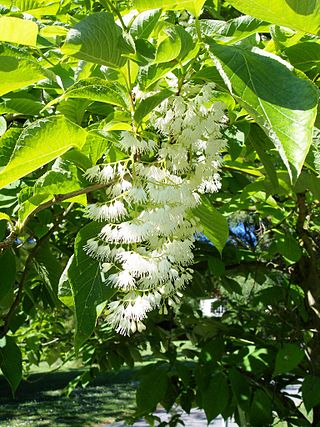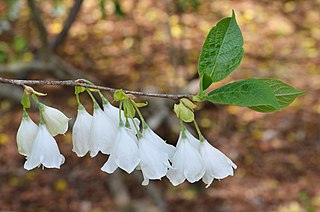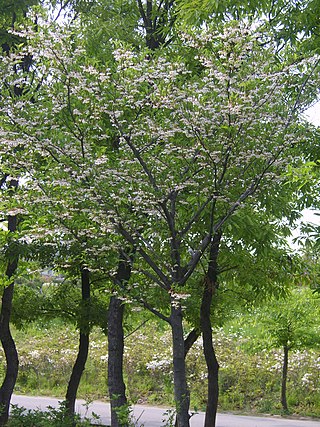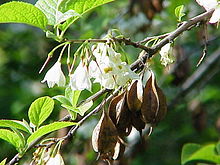
Rosaceae, the rose family, is a medium-sized family of flowering plants that includes 4,828 known species in 91 genera.

Styrax is a genus of about 130 species of large shrubs or small trees in the family Styracaceae, mostly native to warm temperate to tropical regions of the Northern Hemisphere, with the majority in eastern and southeastern Asia, but also crossing the equator in South America. The resin obtained from the tree is called benzoin or storax.

Pterostyrax, the epaulette tree, is a small genus of four species of deciduous large shrubs or small trees in the family Styracaceae, native to eastern Asia in China and Japan. They grow 4–12 m (13–39 ft) tall, with alternate, simple ovate leaves 6–17 cm (2–7 in) long and 4–10 cm (2–4 in) broad. The flowers are white, produced in dense panicles 8–25 cm (3–10 in) long. The fruit is an oblong dry drupe, with longitudinal ribs or narrow wings.

Halesia, also known as silverbell or snowdrop tree, is a small genus of four or five species of deciduous large shrubs or small trees in the family Styracaceae.

Halesia tetraptera, commonly known as the common silverbell or mountain silverbell, is a species in the family Styracaceae, native to the southeastern United States. It is cultivated as an ornamental tree.
Halesia macgregorii is a species of flowering plant in the family Styracaceae. It is endemic to southeastern China, where it grows at moderate altitudes of 700–1,200 m. It is threatened by habitat loss. Recent genetic evidence suggests it is probably more closely related to the genus Rehderodendron than to other species of Halesia; it may be transferred to that genus in the future.
Styrax vilcabambae is a species of flowering plant found in the genus Styrax and the family Styracaceae. It is endemic to Peru.

Rehderodendron macrocarpum is a species of flowering plant in the family Styracaceae, native to southwestern China and northern Vietnam, where it grows at altitudes of 1,000–1,500 m. It is threatened by habitat loss.

Rehderodendron is a genus of five species of flowering plants in the family Styracaceae, native to southeastern Asia, from southwestern China south to Myanmar and Vietnam.

Sinojackia is a genus of five to eight species of flowering plants in the family Styracaceae, all endemic to China.

Sinojackia xylocarpa is a species of flowering plant in the family Styracaceae. It is endemic to eastern China in Jiangsu province, where it occurs at altitudes of 500–800 m. It is threatened by habitat loss.
Changiostyrax is a monotypic genus of flowering plant in the family Styracaceae. Its only member species is Changiostyrax dolichocarpus, formerly known as Sinojackia dolichocarpa.

Styrax obassia is a species of flowering plant in the family Styracaceae. It is native to eastern China, Korea, and Japan (Hokkaido).

Halesia carolina, commonly called Carolina silverbells or little silverbells, is a species of flowering plant in the family Styracaceae, native to the southeastern United States.

Halesiamonticola, the mountain silverbell, is a species of flowering plant in the small family Styracaceae. This large deciduous shrub was originally included in H. carolina, but was identified first as a subspecies by Rehder in 1914 and then as a species by Sargent in 1921. More recently, some authoritative sources regard it only as a subspecies or variety, while other authoritative sources regard it as a species, as it is treated here.

Pterostyrax hispidus, the epaulette tree or fragrant epaulette tree, is a species of flowering plant in the family Styracaceae, native to China and Japan. Growing to 15 m (49 ft) tall by 12 m (39 ft) broad, it is a substantial, spreading, deciduous shrub with oval leaves up to 20 cm (8 in) long, and clusters of pure white, fragrant, pendent flowers in summer.

Styrax grandifolius, the bigleaf snowbell or bigleaf storax, is a plant species native to the southeastern United States, ranging from Virginia south to Florida and west to Texas and Missouri. The plant grows as a deciduous shrub or tree up to 6 metres (20 ft) high, and is most commonly found in upland forests of the southeast's piedmont. As the specific epithet suggests, the species has larger leaves than sympatric Styracaceae, with alternate, obovate leaves up to 14 cm long and 10 cm wide that are densely pubescent underneath. Flowers are borne during early summer in racemes containing up to 20 flowers.

Styrax redivivus, with common names that include snowdrop bush, California styrax, bitternut, drug snowbell, and chaparral snowbell, is a species of flowering plant in the family Styracaceae. It is a rare plant, native to California, a shrub which can grow to 4 metres (13 ft) in height.

Styrax japonicus, also known as the Japanese snowbell, is a species of flowering plant in the family Styracaceae, native to Korea, Japan, and Southern China. Growing to 12 m (39 ft) tall by 8 m (26 ft) broad, it is a graceful, spreading deciduous tree with oval, upward-facing leaves which occasionally turn yellow or orange before falling in autumn. Masses of slightly fragrant, bell-shaped white flowers hang from the branches in summer, followed by fruits (drupes) which resemble olives in both shape and colour.
Perkinsiodendron is a genus of flowering plants belonging to the family Styracaceae.



















